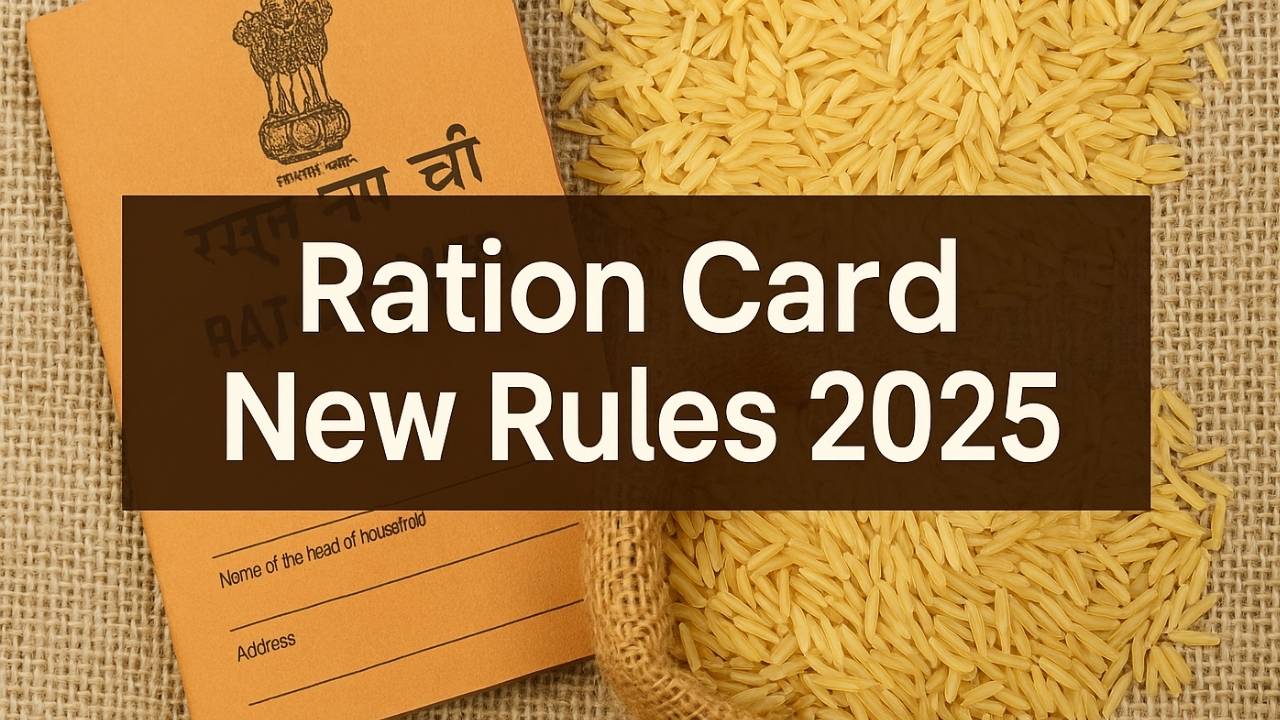The ration card has been a cornerstone of India’s Public Distribution System (PDS) for decades, offering subsidized food grains and essential commodities to eligible households. With over 80 crore beneficiaries, it plays a critical role in ensuring food security. However, challenges such as duplication of cards, inclusion of ineligible beneficiaries, and leakages in the supply chain have long plagued the system.
In response to these concerns, the Government of India introduced a revised set of guidelines under the Ration Card Rules 2025, aiming to increase efficiency, plug systemic loopholes, and expand access through digital infrastructure. These rules mark a decisive shift from a fragmented, state-bound system to a more unified, transparent, and technology-driven model of welfare delivery.
Aadhaar Linkage and Smart Ration Cards Replace Legacy Documents

One of the pivotal reforms in the 2025 update is the complete integration of Aadhaar numbers with all ration cards. This step has been taken to eliminate fake or duplicate cards and ensure that entitlements are received only by the actual beneficiaries.
The government has also introduced Digital Smart Ration Cards, embedded with a microchip. These cards store household data such as family size, income bracket, subsidy history, and biometric identification. These cards can be authenticated at biometric-enabled Point-of-Sale (POS) devices installed at Fair Price Shops (FPS), making transactions faster and reducing dependency on paper records.
This transition not only streamlines operations but also improves traceability and record accuracy across state borders. The digital interface also allows families to update household data, such as new births, deaths, or changes in address,s more efficiently.
Annual e-KYC and Revised Eligibility Criteria for All Beneficiaries
To maintain accuracy and minimize misuse, every household is now required to complete an annual e-KYC (Electronic Know Your Customer) verification. This is mandatory for both new applicants and existing cardholders. e-KYC includes Aadhaar-based biometric verification of each family member and submission of basic income or residence proof.
Households that fail to complete e-KYC within the government-prescribed deadline risk temporary deactivation of their ration card. They will remain ineligible to receive any entitlements until verification is completed.
Further, the eligibility criteria for availing ration benefits have been refined based on the updated income slabs, family size, and urban-rural classifications. These reforms seek to ensure that only genuinely eligible households access subsidized resources, thereby optimizing government expenditure on food security.
Eligibility and Verification – Then and Now
| Feature | Before 2025 | After 2025 Policy Update |
|---|---|---|
| Aadhaar Linkage | Not mandatory in all states | Mandatory for all listed family members |
| Type of Card | Paper or plastic card | Digital Smart Card with Chip |
| Biometric Verification | Rarely enforced | Required at every transaction |
| e-KYC Frequency | Only at the time of issuance | Required annually |
| Income Limit for APL Category | Fixed nationwide threshold | Indexed based on state and inflation |
Flexible Pricing Structure and Direct Benefit Integration
The traditional subsidy structure provided fixed prices for food grains across categories. However, under the 2025 rules, the government has introduced a Dynamic Pricing System. Under this model, prices vary slightly based on market trends but remain significantly lower than retail rates due to continued government subsidy.
The reform distinguishes between Below Poverty Line (BPL) and Above Poverty Line (APL) families. While BPL families will continue to receive heavily subsidized or free rations, APL families will now pay a moderate, pre-determined share, based on monthly market price calculations.
In addition, LPG subsidies are now directly linked to the ration card database, helping verify family size and reduce duplicate or false LPG subsidy claims. This integration also supports Direct Benefit Transfer (DBT), ensuring the subsidy is credited directly to the beneficiary’s bank account.
Ration Item Pricing under the 2025 Dynamic Subsidy Model
| Commodity | Market Price (₹/kg) | Price for BPL (₹/kg) | Price for APL (₹/kg) |
|---|---|---|---|
| Rice | 34 | 3 | 15 |
| Wheat | 28 | 2 | 12 |
| Sugar | 43 | 13 | 25 |
| LPG Cylinder | 1150 (14.2 kg) | Subsidy up to ₹500 | Subsidy up to ₹200 |
This model creates a balanced ecosystem, allowing the government to sustain fiscal support for vulnerable populations while rationalizing its spending on middle-income groups.
Pan-India Portability for Migrants and Mobile Workers
The introduction of a robust One Nation, One Ration Card (ONORC) system enables beneficiaries to collect ration from any part of India, irrespective of their native state or place of card issuance. This development is vital for millions of migrant workers, seasonal laborers, and urban slum residents, whose movement across states previously disrupted their access to entitlements.
To avail of benefits outside their home state, beneficiaries simply need to undergo Aadhaar-based biometric verification at the FPS of their current location. This feature increases the usability of the PDS and ensures that entitlements follow the individual, not just the card.
Migrants can even split their rations across two locations—one in their village for their family, and the other in the city for themselves—under the partial allocation option.
Key Advantages of the ONORC Framework
- Seamless access to ration in any Indian state
- Dual location access for families split across cities and villages
- Reduced dependency on intermediaries and local ration dealers
- Better tracking of ration consumption via a centralized database
- Real-time visibility of entitlement and transaction history via mobile apps
Transparency and Accountability through Real-Time Monitoring
The upgraded ration system is now powered by a centralized monitoring dashboard, operated by the Ministry of Consumer Affairs. Every transaction at the FPS level is recorded in real-time, allowing better visibility into supply chain performance, stock levels, and beneficiary feedback.
All ration shops have been mandated to display QR codes that beneficiaries can scan to verify the authenticity of the FPS and view their past transactions. Geo-tagging of FPS shops and automated alert systems for irregular distribution behavior have also been implemented.
This shift to a data-governed model helps eliminate corrupt practices such as ration diversion, fake entries, or distribution delays. It also opens avenues for policy refinement based on real-time data.
What Every Ration Card Holder Must Do in 2025
- Complete annual e-KYC using Aadhaar before the deadline
- Link your bank account to your ration card for receiving the LPG subsidy
- Regularly check family details and entitlement via the PDS portal
- Use biometric verification at FPS to avoid misuse
- Be aware of pricing slabs under dynamic subsidy rules
Modernizing Welfare for a Secure and Transparent Future
The Ration Card Rules 2025 are a comprehensive set of reforms aimed at transforming India’s food distribution system into a more accountable, portable, and inclusive model. By integrating digital technologies and Aadhaar verification, the government seeks to ensure that every grain distributed through PDS reaches the rightful beneficiary.
Beneficiaries must now be more informed and proactive in updating their records, verifying their entitlements, and completing the annual KYC formalities. With these changes, India’s PDS system moves closer to achieving its objective of zero hunger, while promoting transparency and minimizing systemic inefficiencies.
As a citizen and ration card holder, staying updated on these rules is essential, not just for compliance, but also for fully benefiting from government-supported food security.

Harshit Chahal is a policy writer who focuses on rural development, state-specific welfare schemes, and agriculture-linked benefits. Coming from a small-town background, he brings grounded insights into how government initiatives impact real lives. Harshit is committed to making public policy content accessible for rural and semi-urban readers across India.